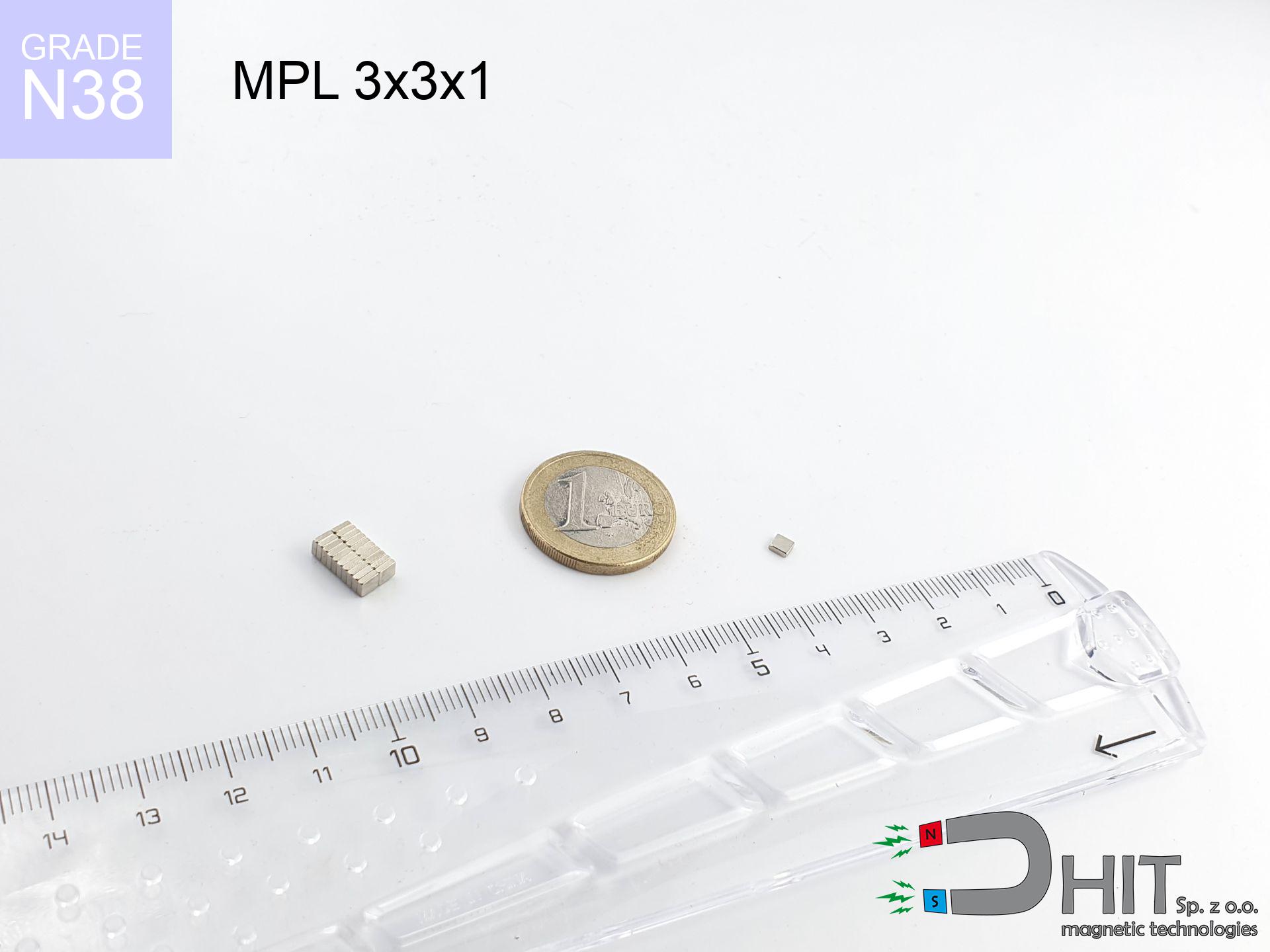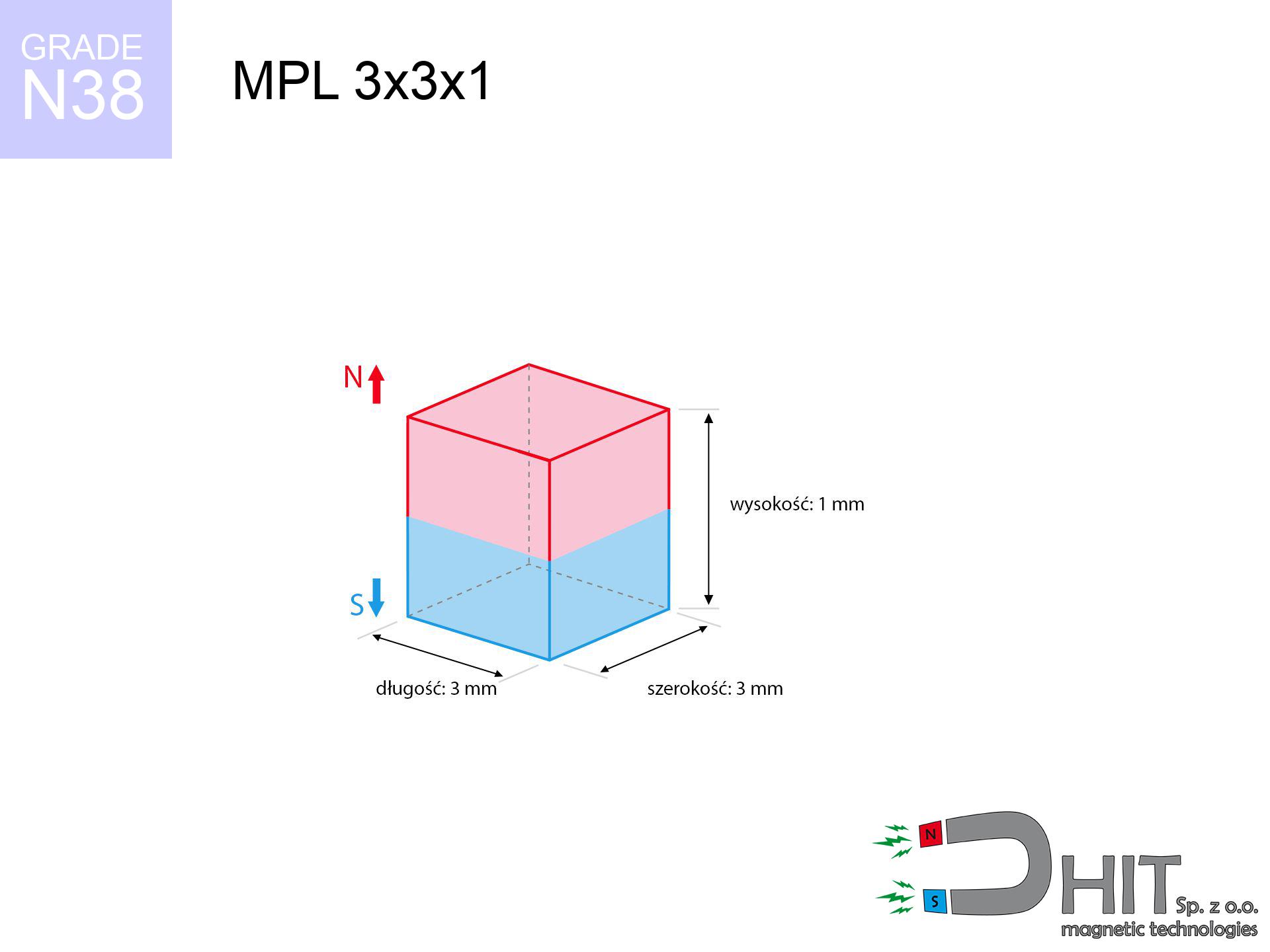MPL 3x3x1 / N38 - lamellar magnet
lamellar magnet
Catalog no 020146
GTIN: 5906301811527
length [±0,1 mm]
3 mm
Width [±0,1 mm]
3 mm
Height [±0,1 mm]
1 mm
Weight
0.07 g
Magnetization Direction
↑ axial
Load capacity
0.24 kg / 2.35 N
Magnetic Induction
317.31 mT
Coating
[NiCuNi] nickel
0.1845 ZŁ with VAT / pcs + price for transport
0.1500 ZŁ net + 23% VAT / pcs
bulk discounts:
Need more?Not sure about your choice?
Give us a call
+48 22 499 98 98
or contact us via
form
the contact page.
Weight and form of magnetic components can be tested using our
online calculation tool.
Same-day shipping for orders placed before 14:00.
MPL 3x3x1 / N38 - lamellar magnet
Magnetic properties of material N38
Physical properties of NdFeB
Shopping tips
Due to their power, flat magnets are regularly used in structures that need very strong attraction.
Most common temperature resistance of these magnets is 80°C, but depending on the dimensions, this value rises.
Additionally, flat magnets commonly have special coatings applied to their surfaces, such as nickel, gold, or chrome, to increase their durability.
The magnet labeled MPL 3x3x1 / N38 i.e. a magnetic strength 0.24 kg weighing just 0.07 grams, making it the excellent choice for projects needing a flat magnet.
Contact surface: Due to their flat shape, flat magnets ensure a greater contact surface with adjacent parts, which is beneficial in applications needing a stronger magnetic connection.
Technology applications: These are often utilized in many devices, e.g. sensors, stepper motors, or speakers, where the thin and wide shape is important for their operation.
Mounting: This form's flat shape makes it easier mounting, especially when it is required to attach the magnet to another surface.
Design flexibility: The flat shape of the magnets allows designers greater flexibility in arranging them in devices, which can be more difficult with magnets of more complex shapes.
Stability: In certain applications, the flat base of the flat magnet may offer better stability, minimizing the risk of shifting or rotating. However, one should remember that the optimal shape of the magnet is dependent on the specific application and requirements. In certain cases, other shapes, like cylindrical or spherical, may be more appropriate.
Magnets have two poles: north (N) and south (S), which interact with each other when they are different. Similar poles, such as two north poles, repel each other.
Due to these properties, magnets are often used in magnetic technologies, e.g. motors, speakers, sensors, or magnetic locks. Neodymium magnets stand out with the highest power of attraction, making them indispensable for applications requiring powerful magnetic fields. Moreover, the strength of a magnet depends on its dimensions and the material it is made of.
It should be noted that extremely high temperatures, above the Curie point, cause a loss of magnetic properties in the magnet. The Curie temperature is specific to each type of magnet, meaning that once this temperature is exceeded, the magnet stops being magnetic. Additionally, strong magnets can interfere with the operation of devices, such as navigational instruments, credit cards or medical equipment, like pacemakers. For this reason, it is important to avoid placing magnets near such devices.
Advantages and disadvantages of neodymium magnets NdFeB.
In addition to their tremendous field intensity, neodymium magnets offer the following advantages:
- Their strength is durable, and after approximately 10 years, it drops only by ~1% (according to research),
- Their ability to resist magnetic interference from external fields is impressive,
- The use of a decorative gold surface provides a refined finish,
- They have very high magnetic induction on the surface of the magnet,
- Neodymium magnets are known for exceptionally strong magnetic induction and the ability to work at temperatures up to 230°C or higher (depending on the magnetic form),
- With the option for customized forming and personalized design, these magnets can be produced in numerous shapes and sizes, greatly improving design adaptation,
- Wide application in new technology industries – they are utilized in data storage devices, rotating machines, medical equipment along with high-tech tools,
- Thanks to their efficiency per volume, small magnets offer high magnetic performance, while occupying minimal space,
Disadvantages of magnetic elements:
- They are fragile when subjected to a sudden impact. If the magnets are exposed to external force, it is suggested to place them in a metal holder. The steel housing, in the form of a holder, protects the magnet from fracture , and at the same time enhances its overall durability,
- High temperatures may significantly reduce the strength of neodymium magnets. Typically, above 80°C, they experience permanent loss in performance (depending on size). To prevent this, we offer heat-resistant magnets marked [AH], capable of working up to 230°C, which makes them perfect for high-temperature use,
- They rust in a moist environment. If exposed to rain, we recommend using waterproof magnets, such as those made of plastic,
- The use of a protective casing or external holder is recommended, since machining fine details in neodymium magnets is risky,
- Potential hazard due to small fragments may arise, in case of ingestion, which is important in the context of child safety. Furthermore, miniature parts from these products have the potential to interfere with diagnostics after being swallowed,
- Due to the price of neodymium, their cost is considerably higher,
Best holding force of the magnet in ideal parameters – what affects it?
The given holding capacity of the magnet corresponds to the highest holding force, determined in the best circumstances, namely:
- with mild steel, used as a magnetic flux conductor
- of a thickness of at least 10 mm
- with a smooth surface
- in conditions of no clearance
- in a perpendicular direction of force
- under standard ambient temperature
Key elements affecting lifting force
Practical lifting force is determined by elements, by priority:
- Air gap between the magnet and the plate, since even a very small distance (e.g. 0.5 mm) can cause a drop in lifting force of up to 50%.
- Direction of applied force, because the maximum lifting capacity is achieved under perpendicular application. The force required to slide the magnet along the plate is usually several times lower.
- Thickness of the plate, as a plate that is too thin causes part of the magnetic flux not to be used and to remain wasted in the air.
- Material of the plate, because higher carbon content lowers holding force, while higher iron content increases it. The best choice is steel with high magnetic permeability and high saturation induction.
- Surface of the plate, because the more smooth and polished it is, the better the contact and consequently the greater the magnetic saturation.
- Operating temperature, since all permanent magnets have a negative temperature coefficient. This means that at high temperatures they are weaker, while at sub-zero temperatures they become slightly stronger.
* Lifting capacity testing was carried out on a smooth plate of suitable thickness, under a perpendicular pulling force, however under attempts to slide the magnet the lifting capacity is smaller. Moreover, even a minimal clearance {between} the magnet’s surface and the plate decreases the holding force.
Exercise Caution with Neodymium Magnets
Under no circumstances should neodymium magnets be placed near a computer HDD, TV, and wallet.
Strong fields generated by neodymium magnets can damage magnetic storage media such as floppy disks, credit cards, magnetic ID cards, cassette tapes, video tapes, or other similar devices. They can also damage televisions, VCRs, computer monitors, and CRT displays. Avoid placing neodymium magnets in close proximity to electronic devices.
People with pacemakers are advised to avoid neodymium magnets.
In the case of neodymium magnets, there is a strong magnetic field. As a result, it interferes with the operation of a heart pacemaker. Even if the magnetic field does not affect the device, it can damage its components or deactivate the entire device.
Neodymium Magnets can attract to each other due to their immense internal force, causing the skin and other body parts to get pinched and resulting in significant swellings.
Magnets will jump and touch together within a distance of several to almost 10 cm from each other.
Neodymium magnets are the strongest magnets ever created, and their power can shock you.
On our website, you can find information on how to use neodymium magnets. This will help you avoid injuries and prevent damage to the magnets.
The magnet coating is made of nickel, so be cautious if you have an allergy.
Studies clearly indicate a small percentage of people who suffer from metal allergies such as nickel. An allergic reaction often manifests as skin redness and rash. If you have a nickel allergy, try wearing gloves or avoid direct contact with nickel-plated neodymium magnets.
Avoid bringing neodymium magnets close to a phone or GPS.
Magnetic fields generated by neodymium magnets interfere with compasses and magnetometers used in navigation, as well as internal compasses of smartphones and GPS devices.
Dust and powder from neodymium magnets are flammable.
Avoid drilling or mechanical processing of neodymium magnets. If the magnet is crushed into fine powder or dust, it becomes highly flammable.
Magnets made of neodymium are especially fragile, which leads to shattering.
Magnets made of neodymium are delicate as well as will break if allowed to collide with each other, even from a distance of a few centimeters. They are coated with a shiny nickel plating similar to steel, but they are not as hard. At the moment of connection between the magnets, tiny sharp metal pieces can be propelled in various directions at high speed. Eye protection is recommended.
Keep neodymium magnets away from children.
Not all neodymium magnets are toys, so do not let children play with them. In such a situation, surgery is necessary to remove them. In the worst case scenario, it can result in death.
Neodymium magnets can become demagnetized at high temperatures.
Under specific conditions, Neodymium magnets can lose their magnetism when subjected to high temperatures.
Safety precautions!
Please read the article - What danger lies in neodymium magnets? You will learn how to handle them properly.




![UMGGW 43x6 [M4] GW / N38 - magnetic holder rubber internal thread UMGGW 43x6 [M4] GW / N38 - magnetic holder rubber internal thread](https://cdn3.dhit.pl/graphics/products/umg-43x6-m6-gw-hel.jpg)




